2. GHANA
Fall in plywood exports drag down 2017 earnings
Data from the Research and Statistics Unit of the TIDD
shows Ghana’s cumulative exports of wood products in
2017 totalled 339,227 cu.m which earned the country a
total revenue of almost Euro190 million.
Compared to 2016 there was an almost 15% decline in
export volumes and a 16% drop in the value of exports.
In 2017 air-dried sawnwod accounted for 64% of export
volumes followed by kiln-dried sawnwood (11%) and
billets (9.5%). Another 10 products made up the balance.

In terms of trends, in 2017 exports of billets
(logs), boules
and curl veneers increased while exports of other products,
particularly sawnwood and plywood, declined.
Ghana’s overland plywood exports plummeted to just
15,549 cu.m in 2017 from a peak of 30,071 cu.m in 2016
and this resulted in the combined export earnings from
plywood and sawnwood to drop by around 48% (Euro
10.33 mil. in 2016 to Euro 5.32 mil. in 2017).
Asia, Ghana’s main export destination
Ghana’s export markets included Germany, Italy, France,
UK and Belgium in Europe, China, India, Vietnam in Asia
and South Africa, Morocco, Cape Verde.
In 2017 poles and billets accounted for 10% of exports
(34,170 cu.m), sawnwood, plywood, boules, veneers and
kindling accounted for 87% of exports while mouldings,
flooring, dowels and furniture accounted just over 3% of
exports. The leading species for these markets were wawa,
teak, ceiba, gmelina, and rosewood.

Asian and Middle East markets accounted for over 70%
of
export volumes in 2017 as well as in 2016. Demand from
Europe and America remained at the same level as in 2016
but sales to African countries fell accounting for just 8%
of exports in 2017 compared to 11% in 2016. The drop in
Africa’s share of Ghana’s exports is attributed to the
almost 50% decline in export volumes destined for
Nigeria.
Calls for tax overhaul
The Association of Ghana Industries (AGI) has called on
government to revise the tax exemption currently granted
to some companies. The AGI says exemptions are
discriminatory and companies benefitting tend to be
importing products that compete directly with locally
manufactured products which has slowed investment in
manufacturing.
Ghana Statistical Service data show that since 2010
growth of the manufacturing sector has been falling from a
high of 10% in 2010 to 4.6% in 2016 and now estimated at
3%, the lowest in more than a decade.
Correction
In the previous ITTO report it was stated that a furniture
test centre has been established by the Timber Inspection
Development Division of the Ghana Forestry Commission,
this was incorrect. The following correction has been
provided by the test centre team.
“To improve the quality and add more value to locally
made furniture a testing facility has been established at the
Forestry Research Institute of Ghana (FORIG) of the
Council for Scientific and Industrial Research (CSIR)
located at Fumesua near Kumasi.
The centre has modern equipment for testing furniture,
plywood and wood-based panels and was made possible
by technical support from UNIDO, with Bern University
of Applied Sciences (BFH) in Switzerland, as the
consultant.
Funding of the project was provided by the Government of
Switzerland under its Trade Capacity Building
Programme. The centre was built was renovated by CSIRFORIG.
This centre, say analysts, is the first of its kind in the West
Africa. The centre is expected to stimulate growth in
Ghana’s added value wood product sectors. The centre
was opened on 6 February 2018 at CSIR-FORIG campus.
Speaking at the function, the Minster for Trade and
Industry, Alan Kwadwo Kyeremanteng, who was
represented by the Director-General of Ghana Standards
Authority (GSA), said that the government will do all it
can to support growth in the wood products sector to lift
Ghana’s productivity and competitiveness locally and
internationally.
A representative of the Minister for Environment, Science,
Technology and Innovation stated that the Government
will ensure that Ghana wood and wood products and
related services are designed, manufactured and traded in a
sustainable manner to match the needs, expectations and
requirements of the consumers.
He added that the second and third wood processing levels
would be strengthened in order to generate more jobs and
to increase added-value production in Ghana.
He expressed concerned about the influx of low quality
and cheap foreign wood products (especially furniture)
onto the Ghanaian market, which according to him, could
be checked through the test centre to ensure that they meet
standards before they enter the local market”.

3.
MALAYSIA
Shortages of raw materials
and skilled workers could
hold back furniture export performance
Malaysia’s timber exports are expected to increase 5% this
year from the RM23.22 bil. in 2017, according to Dr.
Jalaluddin Harun, Director General of the Malaysian
Timber Industry Board (MTIB). His confidence stems
from the high demand for Malaysian timber in Japan, the
United States, member states of the European Union,
Australia and India.
Harun reported that Malaysia ships to more than 160
countries but marketing efforts will be focussed on those
countries with which Malaysia has trade agreements.
The main issues facing the timber sector, said Harun, are
shortages of both raw materials and skilled workers and
this must be addressed. Harun estimated that 80% of
Malaysian made furniture is of rubberwood and efforts
must be made to secure this resource for the domestic
industry.
‘Design Connects People’ – theme for Malaysian Fair
The Malaysian International Furniture Fair (MIFF) 2018 is
eyeing a 5% increase in sales this year despite the recent
rise in the ringgit against the US dollar. The annual event
recorded sales of US$940 mil last year.
As Malaysia prepares for the Malaysian International
Furniture Fair (MIFF) 2018, Tan Chin Huat, MIFF
founder and chairman, said the strengthening ringgit was
unlikely to affect exports as overseas buyers are more
concerned about design and quality.
This year the theme for MIFF is “Design Connects
People”, and the Fair will run between March 8-11. The
organisers say the Fair is expected to attract 600 exhibitors
from countries with 70% of the fair space being taken up
by Malaysian exhibitors.
For more see: http://2018.miff.com.my/
Revised fees in Sarawak to impact industry
The Sarawak Forest Department will introduce higher fees
for planted forest timber and also higher transportation
fees for hardwood timber with effect from 1 March this
year.
The fee for planted forest timber will be raised from
RM0.50 per cubic metre to RM1.50 per cubic metre and a
charge of RM1 per cubic metre will be introduced for
natural forest timber to pay for tracking the movement of
logs through the issuance of Shipping Pass or Land
Transport Pass.
4.
INDONESIA
Fiscal incentives to boost
investment
Sri Mulyani Indrawati, Indonesia’s Minister of Finance,
has said the government plans to introduce better tax
incentives to attract business investment.
The focus will be on four incentives namely tax
allowances, tax holidays, tax deductions for small and
medium enterprises and incentives for research and
development. The government is also considering
expanding the range of business sectors that can benefit
from these incentives.
Sustainability bond to finance rubber plantations
The UN Environment Programme has announced a
partnership with the World Agroforestry Centre, ADM
Capital and BNP Paribas for the issuance of a US$95
million Sustainability Bond to help finance sustainable
natural rubber plantations on heavily degraded land in two
provinces in Indonesia.
The UNEP web site says the project involves collaboration
with WWF, which has worked with Michelin and RLU to
set aside remaining High Carbon Stock (HCS) and High
Carbon Value (HCV) forest in the RLU concessions, as
well as conservation of wildlife and riparian areas. Out of
a concession area of 88,000 hectares, roughly 45,000
hectares will be set aside for community livelihoods and
conservation.
See: https://www.unenvironment.org/news-and-stories/pressrelease/
financing-natural-rubber-plantation-indonesia-promotingsustainable
Land allocation – a call for private sector participation
As part of its land reform programme, the Indonesian
government has plans to distribute land certificates over 5
million plots to Indonesian citizens and some 4.2 million
plots have already been designated. The Minister of
Environment and Forestry, Siti Nurbaya Bakar, has said
plots extending over about 2 million hectares of forest land
will be allocated this year.
In related news, the Minister has called upon the private
sector to participate in advancing social forestry.
According to Siti, a number of private parties have
announced their interest to work with communities in
social forestry areas. Several trials have been made and a
number of successful private partnerships have been set up
in the Pati forest area, said the Minister.
Satellite imagery to identify fire risk areas
The UK government, through the International Partnership
Programme (IPP) will provide grant support for efforts in
Indonesia and Malaysia to address the problem of forest
fires.
Sam Gymah, the UK’s Minister of State for Universities
and Science, said the project would be overseen by a
British company utilising satellite imagery to record water
levels on peat lands where forest fires often occur to
provide an early warning system of areas at risk.

5.
MYANMAR
Teak plantation harvests
planned
News is circulating that the Forest Department is planning
to allow harvesting of some mature (over 30-year-old)
commercial teak plantations to partially compensate for
the logging ban in the Bago Mountain Range.
Analysts write that the quality of plantation teak will not
satisfy quality requirements in international markets. As it
is not clear what natural teak harvest levels will be in
2018-19 it is difficult to assess how this will impact
industry.
Myanmar is said to have around 2.2 million acres of forest
plantations about half of which are of commercial value
according to the Ministry of Natural Resources and
Environmental Conservation.
There are approximately 1.2 million acres of forest
commercial plantations in Myanmar (approx. 50% of the
total) a further 30% are plantations in catchment areas and
around 16% are for other uses. In addition there are nearly
450,000 acres of firewood plantations and 6,480 acres of
mangrove plantations. However, the accuracy of these
figures cannot be confirmed as some plantations have been
badly managed or illegally cut.
In related news, the online ‘Irrawaddy Media’ is reporting
that Myanma Timber Enterprise (MTE) will harvest only
10,620 teak trees and 193,412 other timber trees in the
current fiscal year of 2018-19 although it has quota of
19,200 teak trees and 592,330 timber trees annually.
Export earnings well down on previous years
U Khin Maung Kyi, the Deputy Permanent Secretary of
Ministry of Natural Resources and Environmental
Conservation, has been quoted as saying income from
timber exports and domestic trade will exceed the US$90
mil. in fiscal 2017-18 target which ends 31 March 2018.
This represents a considerable decline from past years.
The value of wood product exports before the 2014 log
export ban averaged over US$500 million annually. In
fiscal 2013-14 exports were close to US$1 billion
according to Ministry of Commerce data. In the following
year exports declined to just US$93 million. Between
April and December 2017 timber export were said to be
around US$162 million.
In the latest projected export earnings from the Ministry it
is not clear whether US$90 million is MTE earnings from
log sales to the Industry or the export value since the
Ministry of Commerce has reported earnings of US$162
million for the first nine months of 2017.
EU paying special attention to teak imports
The domestic media (News Watch Weekly) has quoted an
Extractive Industries Transparency Initiative (EITI)
member, Aung Phyoe Kyaw, as saying that timber exports
to the EU have been temporarily suspended because of the
strict implementation of the FLEGT licensing system.
Analysts write that this is not correct and that timber
exports to the EU have not been suspended but that the
Competent Authorities of EU Member States which are
responsible to verify due diligence by importers are paying
special attention to imports of Myanmar teak.
February teak auction prices sky-rocket
Prices at the February MTE teak log auction sky-rocketed
this month especially for the SG4 and SG5 grades.
One lot of SG4 teak logs attracted a price of US$6,099 per
H.ton, the highest ever recorded by MTE.
Analysts say most traders at the auction were caught by
surprise at the high prices and have put this down to a new
buyer for the Indian market entering the trade.

6. INDIA
Manufacturing output climbs and
business confidence
rises
The good news on December industrial production,
particularly manufacturing output and a dip in retail
inflation, has been interpreted as signaling that the
economy is stabilizing leading analysts to be optimistic on
third quarter 2017 GDP.
In another signal that economic sentiment may be
improving, the quarterly Business Confidence Index,
released separately on Monday by the Delhi-based
economic think tank National Council of Applied
Economic Research (NCAER), registered a growth of
9.1% in January, after declining for two consecutive
quarters.
Despite living longer with parents millennials aspire to
own a home
A recent survey, the results of which are presented in a
press release from CREDAI, has found that over 80%
Indian millennials still live with their parents but that a
majority aspire to own a quality home.
The survey for this report was conducted by the CREDAI
Youth Wing in association its partner the Los Angeles
based CBRE, one of the largest commercial real estate
services and investment company in the world.
The report highlights the major trends created and driven
by millennials, addresses issues such as why millennials
live with their parents longer and how millennial
consumers spend, save and play.
CREDAI says the report challenges common perceptions
and serves as one of the most authoritative studies ever
undertaken on such a demographic.
See: https://credai.org/press-releases/credai-youth-wing---cbrereport-
finds-millennials-and-youth-as-future-demand-drivers-foraffordable-
housing
Big plans to expand forest cover
At the opening of the Commonwealth Forestry Conference
in Dehradun, Ajay Narayan Jha, from the Ministry of
Environment and Forests, reported that India has a 24%
forest cover and that the government plans to increase this
to raise the carbon sink to 2.5 to 3 billion tonnes in 2030.
The focus will be on planting trees outside the forests and
in the agro-forestry sector according to the former Forestry
Director General S.S Negi, also present at the conference.
In related news, the government has announced its plans
for managing its compensatory afforestation fund created
from deposits by agencies when forest land was utilised
for non-forest purposes such as industrial development or
infrastructure.
For more see:
http://www.mahaforest.gov.in/fckimagefile/The%20Compensatt
ory%20Afforestation%20Fund%20Rule,%202016-
24_04_2017.pdf
Teak and hardwood auction prices
Auctions at various forest depots in North and South
Dangs Divisions have been concluded. Some 5,000 cubic
metres, mostly teak logs were offered along with other
tropical hardwoods.
Analysts report one interesting development at the recent
auctions was the purchase of Laurel (Terminalia
tomentosa), by a musical instrument manufacturer. The
price offered was as high as Rs.1,300 per cu.ft.
This manufacturer is trying to promote laurel as an
alternative to rosewood in the production of musical
instruments for export as shipping rosewood, even locally
grown rosewood, is a major problem because of the
CITES regulations.

First quality non-teak hardwood logs 3-4m long
having
girths 91cms & up of haldu (Adina cordifolia), laurel
(Terminalia tomentosa), kalam (Mitragyna parviflora) and
Pterocarpus marsupium attracted prices in the range of
Rs.800-1300 per cu.ft. Second quality hardwood logs were
sold at between Rs.600-700 and low grade logs sold for
Rs.250-400 per cu.ft.
Imported plantation teak
Analysts report demand for imported teak logs remains
stable but there are growing concerns on the quality and
girths of imported plantation teak logs. The weaker US
dollar is an advantage for importers but Indian importers
are resisting supplier’s requests for better prices.
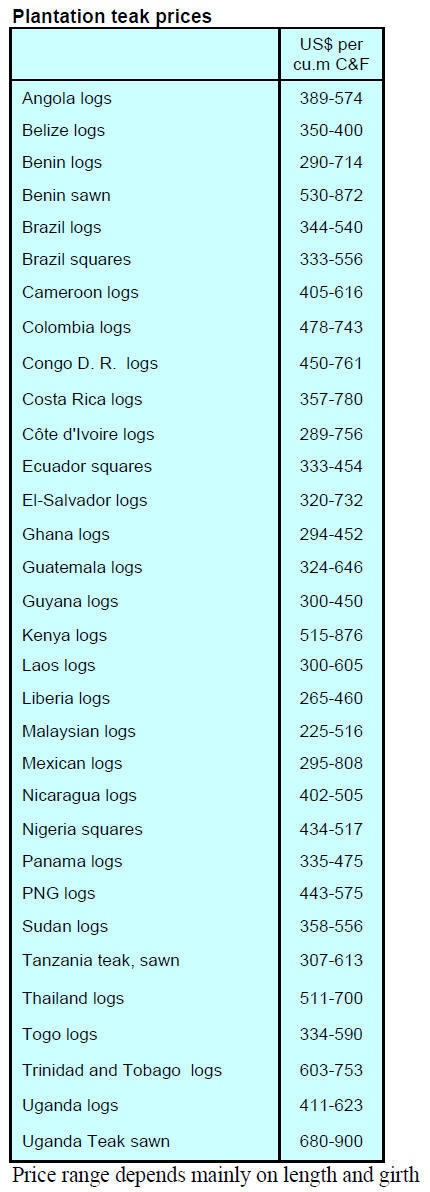
Locally sawn hardwood prices
Building work has picked up say analysts and demand for
hardwoods has been rising and this is expected to be
maintained for some time. In the face of rising
consumption, shippers are looking to raise prices but, say
analysts, competition in the retail sector is stiff such that
there is little room for price increases.
The functioning of the building sector has improved since
the government introduced the "Real Estate Regulatory
Act" which protects home buyers from builders who
unnecessarily delay completing construction work or are
slow in handing over homes to buyers.
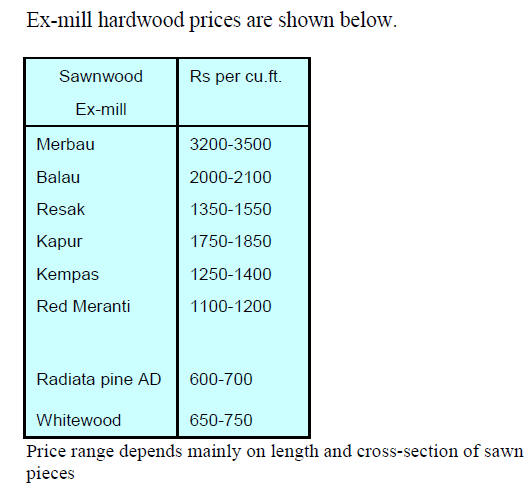
Imported sawn Myanmar teak
The level of imports of Myanmar teak are reported as
stable and the competition with alternative timbers is
becoming more intense.
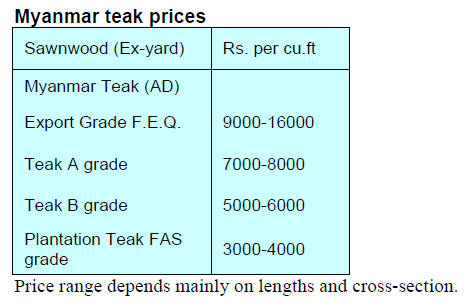
Prices for imported sawnwood
Prices for imported sawnwood (KD 12%) remain
unchanged.
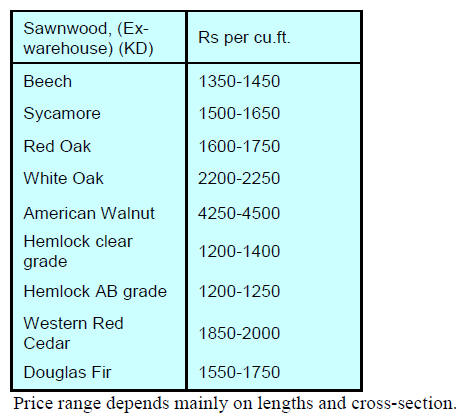
Domestic plywood prices
Analysts write that plywood prices are likely to rise in the
near future given the firm construction demand
additionally there are reports that demand for logs is rising
which will eventually lead to higher log prices which will
have to be passed on at some time.
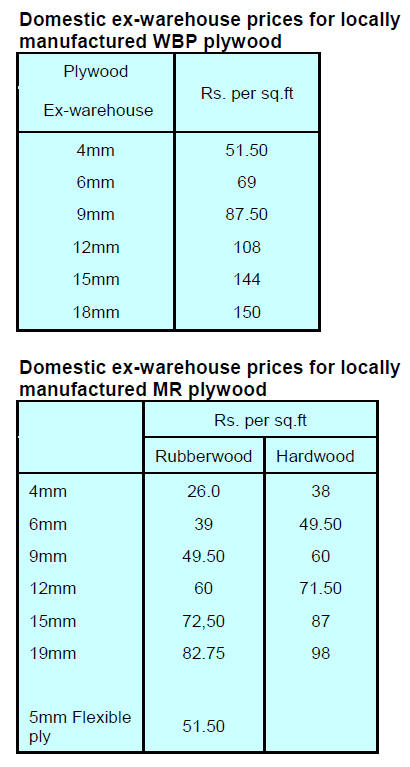
7. BRAZIL
Prospects for veneer production from
plantation
grown paricá
The Brazilian Agricultural Research Corporation
(EMBRAPA), in partnership with a timber company, is
exploring prospects for veneer production from plantation
grown paricá (Schizolobium amazonicum) which is
present in the lowland Amazon forest.
Trials have shown that out of 10,000 planted seeds about a
third germinated and grew to harvestable trees with a
diameter of around 25cm after 13 years and that an
average growth of three cubic metres per hectare/year was
achieved.
The volume of trees with a diameter of over 25 cm was
113 cu.m/ha in the plantation area compared to 95 cu.m/ha
in the non-planted area. When converted to veneer the
profit would be around R$16,863/ha for plantation grown
stock and R$12,381/ha in the non-planted area.
Researchers found that in paricás plantations on degraded
land other species began to propagate naturally and after
thirteen years the timber in the area had a commercial
value 36% higher than that of a degraded plot of the same
size where no remedial measures had been conducted.
According to EMBRAPA, there are more than 19 million
hectares of degraded forest that needs attention in Pará
state and that the use of paricá has great promise in Pará
and the wider Amazon. However, to be commercially
viable it would be necessary to make changes to
legislation that restricts natural forest species logging to
trees with a diameter of 50cm or more and of an age of at
least 50.
Export update
In January 2018, Brazilian exports of wood products
(except pulp and paper) increased 28.8% in value
compared to January 2017, from US$183.7 million to
US$236.6 million.
The value of pine sawnwood exports increased 23%
between January 2017 (US$33.6 million) and January
2018 (US$41.2 million). In terms of volume, exports
increased 18% over the same period, from 168,300 cu.m
to 198,900 cu.m.
In contrast tropical sawnwood exports fell around 12% in
volume, from 32,800 cu.m in January 2017 to 29,000 cu.m
in January 2018. But unit prices were higher such that
export values fell less than 1% over the same period.
Pine plywood export values increased a startling 55% in
January 2018 in comparison with a year earlier from
US$34.8 million to US$54.0 million. The volume of
plywood exports increased but by only 27% over the same
period, from 133,000 cu.m to 169,400 cu.m.
As for tropical plywood, exports increased in both volume
and value, from 10,600 cu.m (US$3.9 million) in January
2017 to 12,300 cu.m (US$ 5.1 million) in January 2018.
The good news on exports continued with for wooden
furniture where export values rose from US$26.6 million
in January 2017 to US$32.0 million in January 2018, a
20% rise.
Furniture exports begins favorably in 2018
2018 started well for furniture exports (all types), reaching
US$41.7 million compared tor US$37.5 million last year.
For the three main markets, the United States, the United
Kingdom and Argentina, the value of January 2018
exports topped US$20 million (US$18.5 mil. in 2017),
accounting for almost 48% of all furniture exports.
In terms of imports, in January imports rose 16% jumping
from US$45.1 million in January last year to US$51.6
million this January. Shippers in China increased their
share of the Brazilian market, from 31% of imports in
January last year to almost 38% in the first month of 2018.
Most Mato Grosso forests covered by management
plans
The forest-based sector in Mato Grosso state, a large
timber producing state, is committed to improving the
sustainability of forest activities, seeking new markets and
encouraging exports.
Data published by CIPEM (the Center for Timber
Producers and Exporters of Mato Grosso State) show that
93% (262,500 hectares) of the legally logged areas in the
state is covered by Sustainable Forest Management Plans
(PMFS) approved by the State Environmental Secretariat.
Additionally, it has been reported that there was a
significant drop in identified illegal forest activities.
The CIPEM report emphasises the contribution to the
State of the forest sector which is supporting around
90,000 direct and indirect jobs, represents the fourth
largest contributor to the state economy and produces
around 13 million cu.m for domestic production.
In addition, sustainable forest management provides
important environmental services, such as carbon
sequestration and sustainable harvesting of non-timber
products.
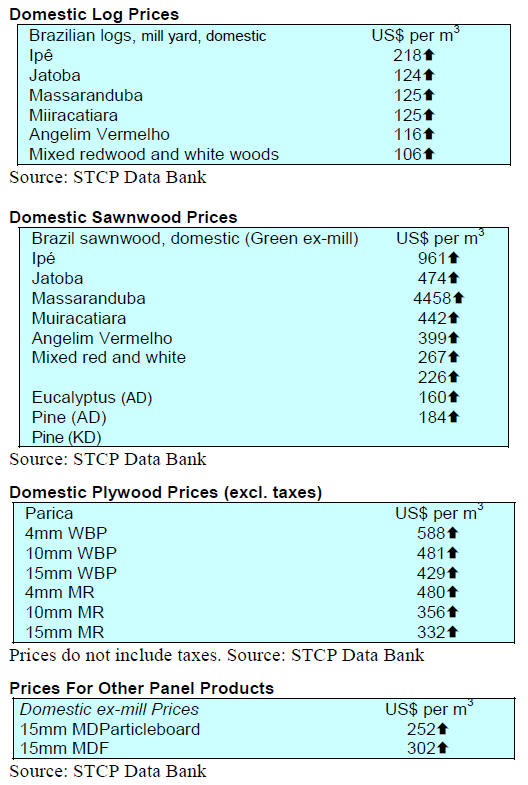

8. PERU
Timber companies at ‘BIG 5’
Dubai fair
A delegation of Peruvian timber entrepreneurs participated
in the ‘Big 5’ Dubai 2017 Fair considered one of the most
important construction and timber sector fairs in the
Middle East.
Companies participated in business meetings, visited
factories and exchanged information on markets in the
region, a major importer of tropical timber especially of
products for the construction sector.
The fair attracts the participation of large business groups
and buyers of wood products not only from the Middle
East but also from the USA, Europe and Asia.
Conserving and utilising Amazon forests – new
initiative to be launched
The Ministry of Agriculture and Irrigation (MINAGRI) is
planning to approve the implementation of numerous
projects worth around US$6.5 million for the recovery,
conservation and sustainable use of resources in Amazon
forests.
The projects were selected after a third call for competitive
bids for funds in the ‘SERFOR-CAF Sustainable,
Inclusive and Competitive Forestry Development
Program’ for the Peruvian Amazon.
The selected projects, to be implemented over a two year
period, reflect the need to recover and protect the Amazon
basins, recover the degraded ecosystems and promote
ecotourism. Projects will be implemented in the Amazon
regions of Junín, Madre de Dios, Amazonas, Huánuco,
San Martín, Pasco, Loreto and Ucayali. Nine of the
projects are dedicated to promoting the sustainable use of
forest products and protection of the ecosystem.
Mission to Dominican Republic
The consultancy company, Tropical Forest, is organising a
trade mission to the Dominican Republic for domestic
timber entrepreneurs from 8 -11 March.
The group of Peruvian business people will visit industrial
wood processing plants and conduct business meeting with
prospective buyers. Dominican importers have expressed
an interest in securing supplies of sawnwood, decking,
flooring and construction products.


